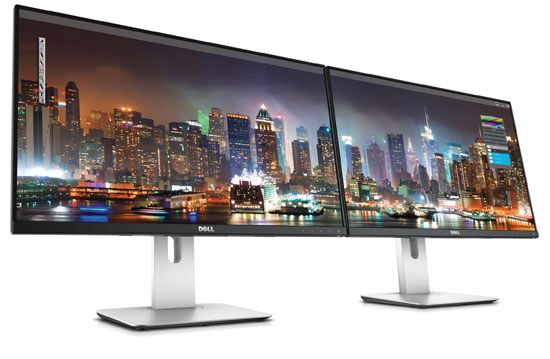In a recent post, we learned how monitor screen resolutions have changed immensely over the past few years. Yet screen resolutions aren’t the only technology improvements you can take advantage of with Dell’s Ultra HD monitors. New connectivity options are another reason why it’s time to refresh your organization’s displays to Dell Ultra HD monitors; if you haven’t upgraded your displays lately, you could be limiting your employees with outdated ports, as you can see in this video.
We’ve already covered how seeing more can help you do more, but connectivity can also affect productivity, especially if your organization is still using outdated technologies. For instance, refreshing with Dell’s Ultra HD displays can provide the option of connecting your latest camera, smartphone or tablet to the Dell 28 Ultra HD 4K Monitor (P2815Q), adding a whole new aspect to computing and making it easier to see a small image on the larger screen which can help boost productivity.
Dell offers a wide array of connectivity options. From HDMI to DisplayPort, we know there’s no “one size fits all” approach to connectivity – that’s why we give our customers the ability to choose their preference. Dell’s Ultra HD monitors offer a plethora of the latest connectivity options, including DisplayPort, mini-DisplayPort, HDMI 1.4, USB 3.0 ports, and a 6-in-1 media card reader.
In an article titled HDMI vs. DisplayPort: Which display interface reigns supreme?, PC World’s Michael Brown explored which option works best, concluding that they complement each other and both offer unique features. He states, “Unfortunately, many computer manufacturers—especially those building consumer laptops and all-in-ones—seem to have decided that HDMI is enough. Here’s hoping that this attitude changes, because DisplayPort offers at least as much to consumers as it does to business users.” Different professions require different uses from their monitors, so Dell leaves the connection choice up to you by offering both DisplayPort and HDMI in our Ultra HD monitors.
Additionally, one of the most prominent updates to peripheral connectivity is the arrival of USB 3.0. Kingston Technology defines USB 3.0 as “the next major revision to the Universal Serial Bus (USB). It offers the same ease-of-use and plug and play capabilities as previous generations of USB technologies but with a 10X performance increase and better power management.” USB 3.0 allows multiple streams of data transfer and exponentially enhances its peak bandwidth over USB 2.0. Dell’s Ultra HD monitors provide four USB 3.0 ports, while some competitors’ 4K offerings don’t even include USB 3.0 at all!
At Dell, we’re catering to a new workforce of power users whose jobs will truly become easier by utilizing one of our Ultra HD monitors. Purchasing Dell’s Ultra HD displays will also help future-proof your organization’s monitor technology, as many analysts and industry pundits believe 4K will become the new norm in years to come.
Discover your inspiration and bring your creations to life with Ultra HD resolution, and let Dell give you the power to do more – and see more. I invite you to join in here with feedback and questions.
